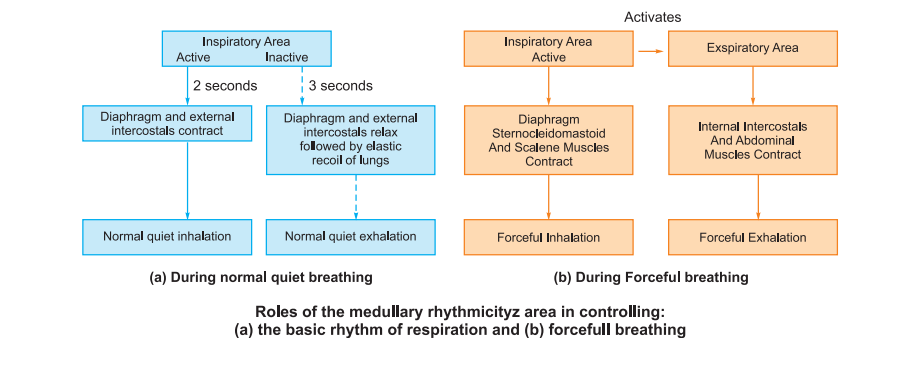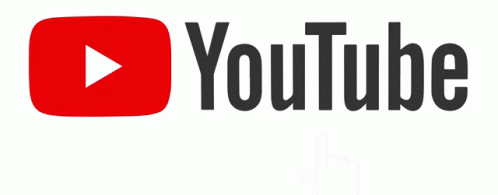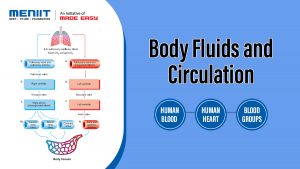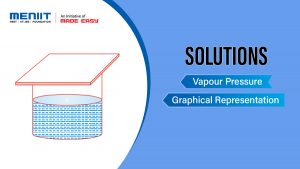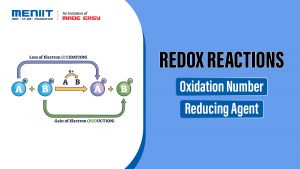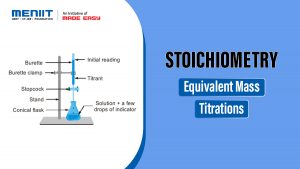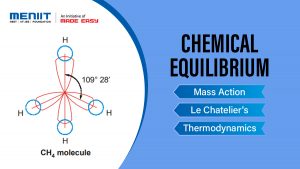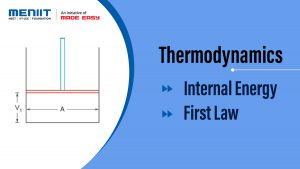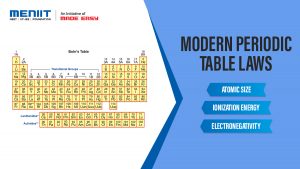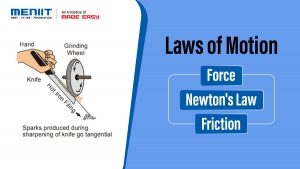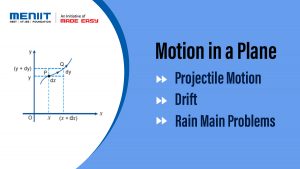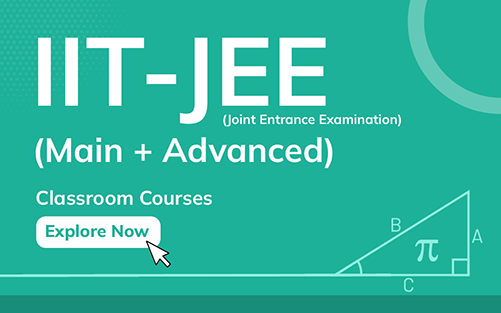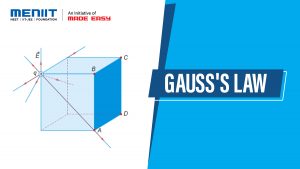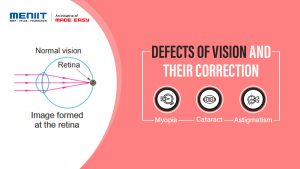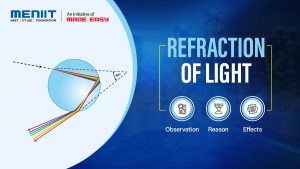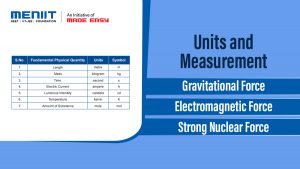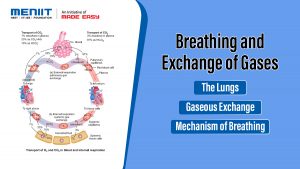Breathing and Exchange of Gases
INTRODUCTION : BREATHING AND EXCHANGE OF GASES
Any process that uses oxygen and produces carbon dioxide is a respiratory process. The energy for growing, moving and thinking comes from food. The body pries this energy out of food molecules using a biochemical process called cellular respiration. While the term cellular respiration pertains to respiration at the cellular level, the general term respiration describes the uptake of oxygen from the environment and the disposal of carbon dioxide at the body system level.
Respiration is the involuntary catabolic process which involves exchange of environmental oxygen and body’s carbon dioxide. The oxygen is utilized for the oxidation of glucose in the mitochondria to produce energy
HUMAN RESPIRATORY SYSTEM
- Respiratory system is endodermal in origin.
- Respiratory system is composed of conducting portion and a respiratory portion.
- The conducting portion provides a passage way for air and functions to condition the incoming air by warming, moistening and cleaning it. It consists of nasal chamber, nasopharynx, larynx, trachea, bronchi, bronchioles and terminal bronchioles.
- The respiratory portion consisting of terminal bronchioles, alveolar ducts and alveolar sacs that serves to get rid the body of CO2 and pick up O2
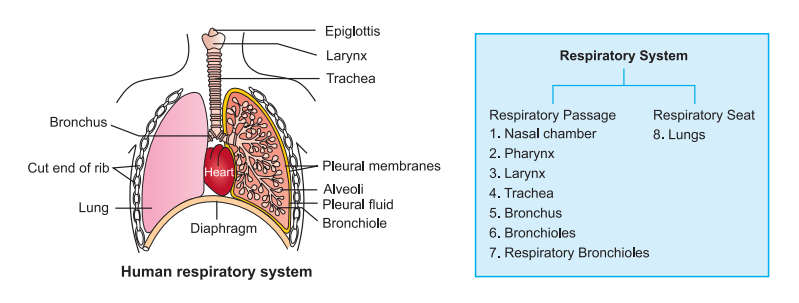
Bronchi and Bronchioles
Our trachea is about 12 cm long and 2.5 cm thick. After reaching into thorax (= chest), it bifurcates into two short primary or principal bronchi, one for each lung. The right bronchus is shorter, wider and more vertical than the left one. Inside the lung, the primary bronchus divides into secondary bronchi, secondary bronchi into segmental bronchi and the latter into bronchioles.
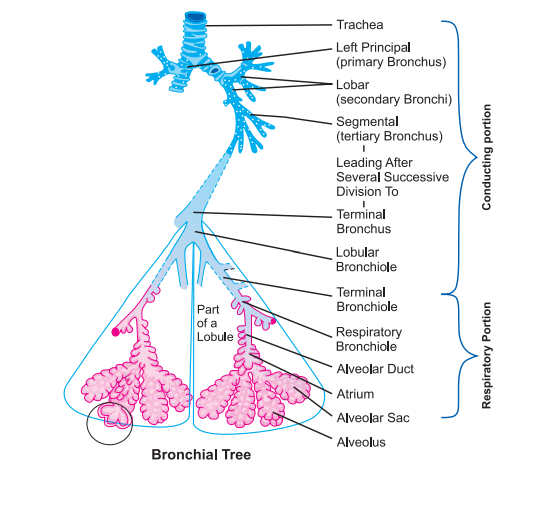
The Lungs
Our two lungs are large, cone-shaped, soft, rosy and spongy structures. These extend from just above the collar bones (clavicles) upto the diaphragm below, completely filling the right and left parts of our chest cavity with only the heart and contents of mediastinum in between.

Alveoli
- The alveoli are the final branching of the respiratory tree and are tiny air sacs which act as the primary gas exchange units of the lung where the exchange of oxygen and carbon dioxide takes place. Each human lung contains about 300 million alveoli which is wrapped in a fine mesh of capillaries covering about 70% of its area.
Thoracic cage: Coverings of thoracic cavity makes thoracic cage.
Anterior surface : Clavicle bones, Neck Posterior surface : Diaphragm Dorsal surface : Vertebral column and ribs Ventral surface : Sternum and ribs Lateral surface : Ribs
MECHANISM OF BREATHING
Humans breathe regularly at a fixed rate throughout life by alternate expansion (inspiration) and compression (expiration) of their lungs brought about by alternate expansion of their thoracic cavity and chest.
Inspiration: The diaphragm contracts, pulling backwards by partial flattening, and increasing the volume of thoracic cavity lengthwise / in the anterior-posterior direction. Simultaneously, the external intercostals muscles also contract, pulling the ribs and sternum outwards and forwards, increasing the diameter/ volume of chest cavity in dorsoventral axis.
Expiration: During normal, quiet breathing, is passive and occurs for three seconds. All muscle contracted for inspiration relax. i.e. diaphragm and external intercostal muscle comes back to its original position.
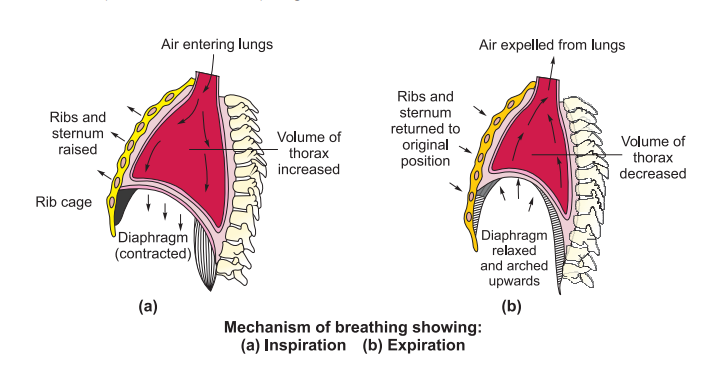
GASEOUS EXCHANGE
Ventilation of lungs in external respiration is accompanied with simultaneous gaseous exchange between blood and alveolar air across the alveolar walls. i.e. diffusion of O2 from alveolar air into the blood and that of CO2 from blood into the alveolar air. O2 and CO2 are exchanged in these sites by simple diffusion mainly based on pressure/concentration gradient. Solubility of the gases as well as the thickness of the membranes involved in diffusion are also some important factors that can affect the rate of diffusion.
- Gaseous Exchange: Gaseous exchange between blood (dissolved phase) and alveolar air (gaseous phase) across respiratory membrane occurs by simple diffusion. As discussed, it depends upon the concentration gradients (partial pressures) of the concerned gases in blood and alveolar air, solubility of the gases in the fluid surface film of respiratory membrane and in the lipid of the cell membranes that constitute the respiratory membrane. Partial pressures of these two gases in the atmospheric air and the two sites of diffusion are given in below Table and in Figure. The data given in the table clearly indicates a concentration gradient for oxygen from alveoli to blood and blood to tissues.
| Respiratory Gas | Atmospheric Gas | Alveoli | Blood (Deoxygenated) | Blood (Oxygenated) | Tissues |
|---|---|---|---|---|---|
| O2 | 159 | 104 | 40 | 95 | 40 |
| CO2 | 0.3 | 40 | 45 | 40 | 45 |
TRANSPORT OF O2 AND CO2 IN BLOOD
Transportation of O2 from the lungs to body tissues and CO2 from tissue to lungs is a vital role of blood
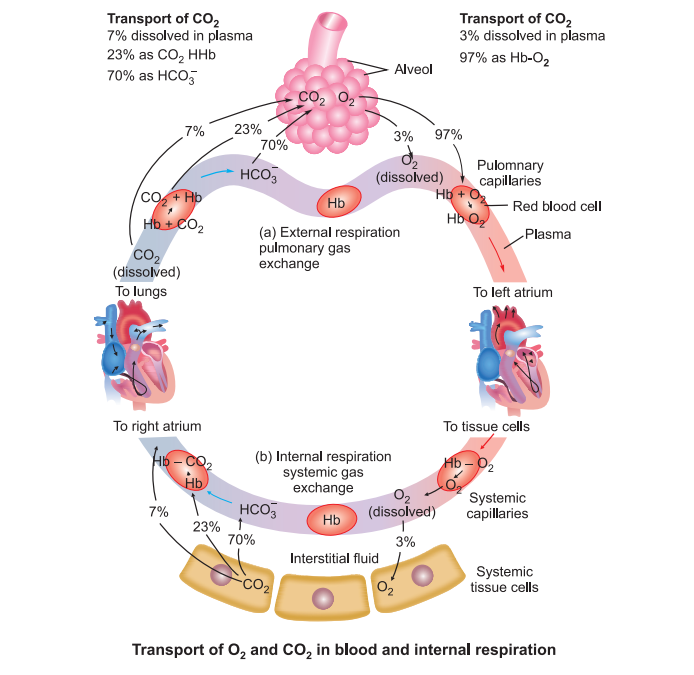
REGULATION OF BREATHING
Normal quiet breathing occurs involuntarily at a fixed rate which varies, not only in different animal species, but also in different individuals of the same species according to age, sex, health, etc. Adult human beings respire 12 to 15 times per minute, but human infants breathe about 44 times per minute. In each breath, in human beings, inspiration accounts for about two and expiration for about three seconds. Regulation of respiration include both nervous and chemical control.
The respiratory centre regulates the rate, as well as, the depth of breathing by coordinating contractions and relaxations of diaphragm and other respiratory muscles This widely dispersed group of neurons, can be divided into three areas on the basis of their functions:
- the medullary rhythmicity area in the medulla oblongata;
- the pneumotaxic area in the pons;
- the apneustic area, also in the pons
